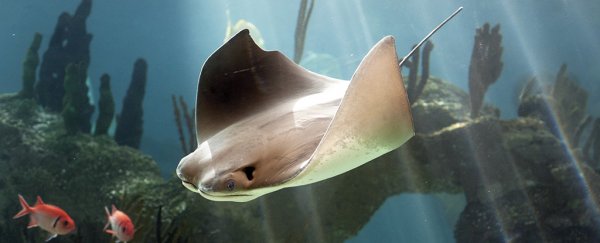The gnashers inside your mouth may well have originated as fish scales, according to new research that found the same type of cells that human teeth have in the thorny scales of the little skate fish.
These neural crest cells were spotted using fluorescent markers to track cells inside the embryo of a little skate, one of the cartilaginous fish group – like sharks and rays – that have skeletons made entirely of cartilage rather than bone.
That means they still have some very primitive characteristics lost in other fish, including the small and spiky scales called dermal denticles that this study is focussing on, according to the international team of researchers.
"By labelling the different types of cells in the embryos of skate, we were able to trace their fates," explains lead researcher Andrew Gillis, from the University of Cambridge in the UK.
"We show that, unlike most fish, the denticle scales of sharks and skate develop from neural crest cells, just like teeth."
"Neural crest cells are central to the process of tooth development in mammals. Our findings suggest a deep evolutionary relationship between these primitive fish scales and the teeth of vertebrates."
 Denticles on the little skate. (University of Cambridge)
Denticles on the little skate. (University of Cambridge)
The question of whether ancient fish scales eventually moved to the mouth to become teeth, or teeth had their own, separate evolutionary history has been a long-running debate in biology for a while now.
Recent research on zebrafish and other species has shown scales and teeth developing from different cluster cells in fish embryos, suggesting that the two evolved independently.
Now this research on cartilaginous fish swings the balance back in the other direction: the thinking is that fish like the skate and the shark are a much better indication of what the creatures of ancient times were like.
"The scales of most fish that live today are very different from the ancient scales of early vertebrates," says Gillis. "Primitive scales were much more tooth-like in structure, but have been retained in only a few living lineages."
"Stroke a shark and you'll find it feels rougher than other fish, as shark skin is covered entirely in dermal denticles. There's evidence that shark skin was actually used as sandpaper as early as the Bronze Age."
As the dermal denticle name suggests, these rough, jagged scales are made from dentine, a hard, calcified tissue that makes up most of a tooth and sits just below the enamel, and which is produced by cells called odontoblasts.
Hundreds of millions of years ago it would have acted as armour-plating against predators, suggest the researchers, part of a layered system of protection including bone.
But did these scales also gradually move into the mouth to become the teeth we chomp with today, perhaps via the jawless filter feeders that sucked food from the water? The new research adds weight to that idea, though the case is still far from closed.
What does seem clearer is that we're dealing with several evolutionary paths, according to Gillis.
"This ancient dermal skeleton has undergone considerable reductions and modifications through time," he says.
"The sharks and skate have lost the bony under-layer, while most fish have lost the tooth-like dentine outer layer. A few species, such as the bichir, a popular fish in home aquariums, have retained aspects of both layers of this ancient external skeleton."
The research has been published in PNAS.
